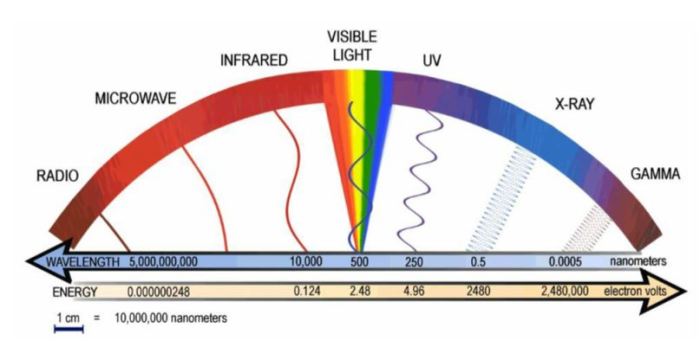Part 3 on Safety
Safety is an important topic in ham radio. There are 11 questions on electrical hazards in the USA Technician class license exam pool, 13 questions on tower safety and associated grounding, and 13 questions on radio frequency (RF) hazards.
Part 1 on general electrical hazards and Part 2 on contact RF hazards were posted previously. This post will address indirect RF hazards. In case you are not familiar with the specifics of RF energy, refer to our post on the subject.
Here we are concerned about non-contact RF energy. A long and involved topic (sorry about that) but full of useful detail.
While it involves radiation, RF energy radiates at lower wavelengths where it is least hazardous.

From the electromagnetic spectrum diagram above we see that radio waves are on the low end of energy levels. As the frequency increases (wavelengths decrease) the energy in electron volts increases exponentially. Energy above 250eV (or so) is ionizing, which in addition to radiation burns can cause cell damage and mutations, leading to cancer and other maladies, as would radioactive material.

Fortunately for hams, all radio frequencies are well below the ionizing radiation energy levels.

Ham radio operators are radio active, not radioactive. 🙂 Now just because RF radiation is non-ionizing doesn’t mean it is completely safe. Besides the direct contact hazard, exposure to radio frequency energy may cause localized tissue heating, particularly in the eyes and male reproductive area (here’s where a lady ham has an advantage, hihi). Non-thermal effects of RF radiation are being studied constantly because, while compelling, they are somewhat ambiguous and unproven.
Now just because RF radiation is non-ionizing doesn’t mean it is completely safe. Besides the direct contact hazard, exposure to radio frequency energy may cause localized tissue heating, particularly in the eyes and male reproductive area (here’s where a lady ham has an advantage, hihi). Non-thermal effects of RF radiation are being studied constantly because, while compelling, they are somewhat ambiguous and unproven.
Because RF energy has this radiated exposure risk, rules and regulations have arisen to protect people from such hazards. In the USA this is done at the federal level by both the FCC (radio communications) and OSHA (occupational). There are also guidelines for RF radiation published by the ARRL and the IEEE. Internationally, most countries apart from the US have similar guidelines, as does the World Health Organization (WHO). References to some of these are given at the end of this presentation.
Specific to US radio amateurs, the FCC instituted RF field exposure limits called Maximum Permissible Exposure (MPE). Continue reading
